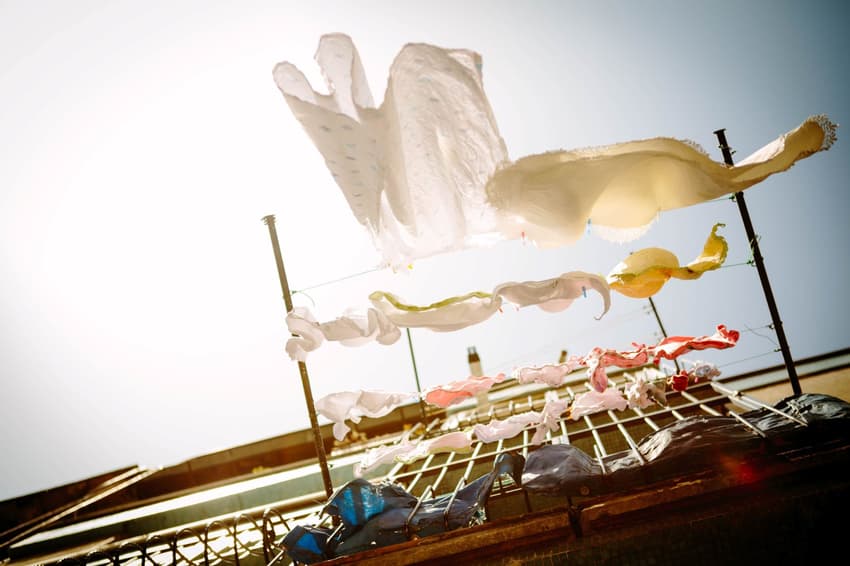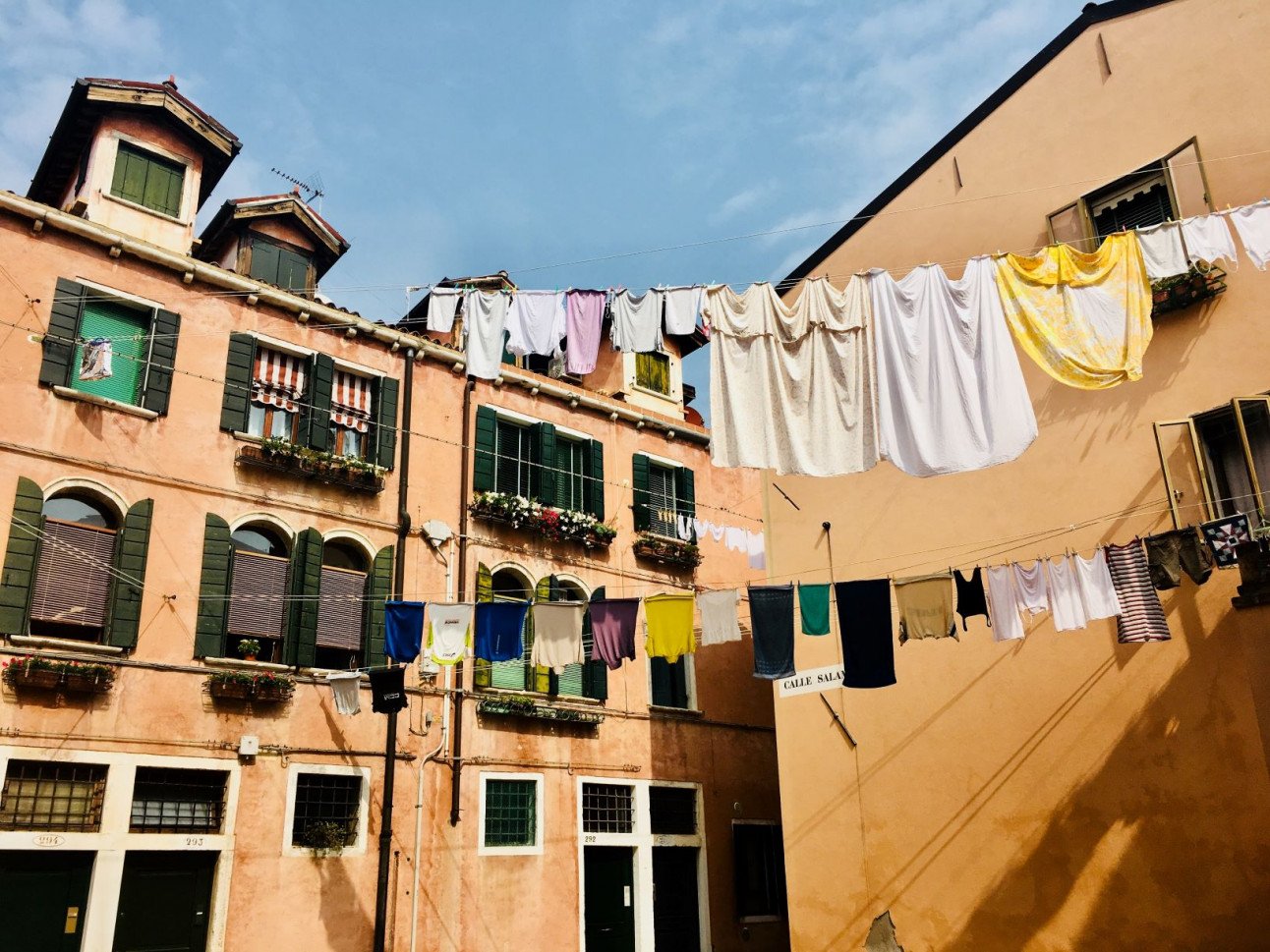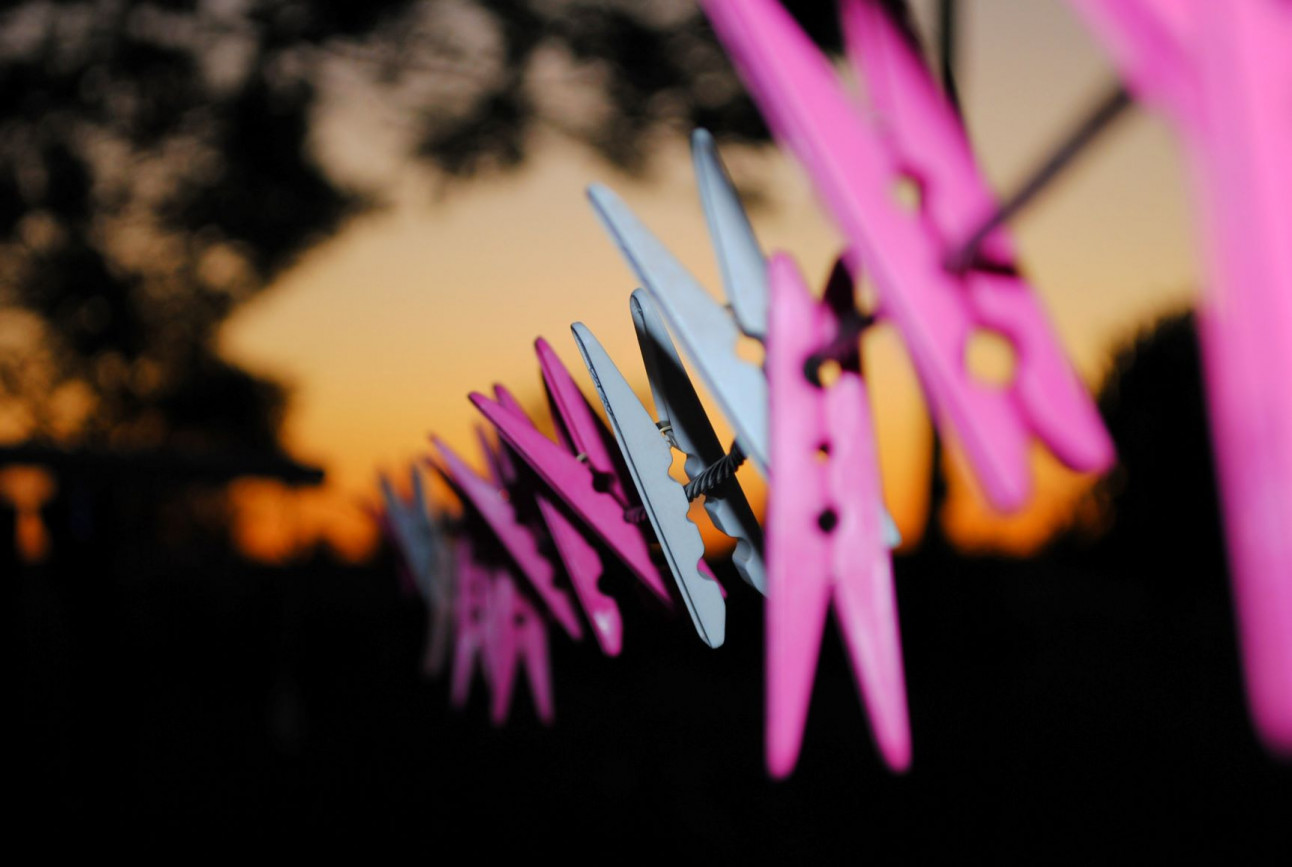Life in Italy: 'Now I've got the hang of it, doing the washing has become almost a pleasure'

Freed from concerns about the unpredictable Scottish weather, Damian Killeen writes about his newfound enjoyment of hanging out laundry since moving to Taranto, southern Italy - along with a new companion.
In the shop the woman said, in Italian, ‘You speak Italian very well’. It was a welcoming lie.
I had struggled to explain that I wanted one of those things over there, to dry my clothes on. "Uno stendino", she said. I paid what I now know was over the odds to possess my first domestic purchase in Italy and carried it back to my apartment, scrutinized, it seemed, by everyone in the street.
Did they share my pleasure and pride in this new acquisition? Or were they staring curiously at this foreigner – a male at that – being seen in public with such an item more commonly associated with a housewife, to whom, I learned, whole emporia full of stendini and other household items are dedicated.
The stendino and I lived together in Taranto in the south of Italy, in a third floor casa vacanza, or holiday let. The owner allowed me to rent the apartment for a longer period than legally allowed so long as I would vacate it for a few days to allow him to let it, for much more than I was paying, to Navy personnel attending an annual recruitment drive. A working trip to Rome meant that I had no problem with this arrangement and I stayed in that flat, with my stendino, for several months.
Not that we were entirely alone. I had friends and other visitors round and even the occasional stopover. But my stendino was a daily presence.
MORE FROM OUR READERS:
-
-
'How Little Britain helped me deal with Italian bureaucracy'
-
'How I found 'home' when searching for my roots in a remote Sicilian village'
I realised that I had not felt the same way about the conventional British ‘clothes horse’, that bore no relationship to any horse I had ever seen, provided limited hanging space and seemed to be more of a nuisance than a help. In truth, I was proud of my stendino; my pride was growing and warming into a feeling of companionship that I had never experienced with any other domestic appliance, except, perhaps, for the double oven in my Scottish home and a few other kitchen gadgets that I remember fondly.
Do Italians, I wondered, feel the same way about their stendini as I do about mine?
The logistics of washing sheets, towels, tablecloths and clothes for myself and guests took a while to sort out in an apartment with no drying machine and no outdoor space, except a small balcony facing the street and a slightly larger one facing the well at the centre of the apartment block.
This balcony also faced all the other balconies in the block, several with their stendini on display.
Stendini, almost invariably white plastic, have X-shaped legs and two wings that, when extended, double the available hanging space. From where I am sitting now there are several to be seen on the front balconies of apartments up to eight stories high, basking in the evening sunlight, some working, i.e. draped in clothes, others just enjoying the final warmth of the day.
Whilst the stendino is good for smaller items of clothing, another fix is needed to cope with sheets, big towels and anything else requiring space and greater exposure. This is provided by three or four lines parallel to the balcony and attached to brackets fixed to either end.
For someone whose ankles turn to jelly when faced with even a picture or film of an edge leading to a drop of more than a few centimetres, the vertiginous prospect of leaning out to hang a sheet on the farthest line brought on an attack of what, in childhood, I had learned to call "the collywobbles".
However, faced with the necessity to get my bedding dry, I forced myself to accept the support of the balcony rail, spread the items out and fixed the pegs with my eyes barely open and my stomach in my mouth. It gets better, but it is still a challenge.
Now that I have got the hang of it, washing has become almost a pleasure, with the washing machine on in the early morning and most things dry by lunchtime. A few hand wash items that take longer to dry decorate my stendino and are ready to come in before the sun goes down.
In contrast with the vagaries of the Scottish weather and the constant anxiety to "bring the washing inside before it rains", the south of Italy offers a degree of laundry security for most of the year that I find particularly reassuring.

Photo: Erin Doering/Unsplash
Meanwhile, if, as happens quite often in the early months of the year, the weather turns foul and the rain buckets down, my stendino accommodates a surprising amount of washing with none of the trauma associated with the lines and can easily be moved inside
The stendino moved with me when I changed apartments to house-sit a granny flat for a friend. There was a stendino already in residence and my first thought was that I should use this rather than replace it with my own; after all, this elderly stendino belonged there.
But it wasn’t long before I began to feel guilty about abandoning my new companion. The resident stendino was soon relegated to a cupboard and mine was re-installed in the role to which we had both become accustomed. This apartment also had its hanging balcony at the back, where my stendino now lives.
I am looking for somewhere else to live in the city, a more permanent arrangement that I can call my home. While the friends who accompany me to view possible purchases explore the size of the rooms, the plumbing arrangements and assess the expanse of the ingenious, above ceiling storage places, I sneak quietly out to the balcony to investigate the clothes drying arrangements and, in particular to see if my stendino might be happy there.
I find it hard to imagine life in Italy without il mio stendino but a recent event brought me face to face with a reality that, so far, I had avoided.
One of my regular tasks is to take the domestic waste out to the array of bins located close to my apartment which are emptied every night around midnight by the City’s waste disposal team.
On this occasion my attention was caught short by the sight of a stendino leaning against one of the bins. Wire framed, not plastic, its paintwork was flaked and scratched. Structurally, however, it appeared complete. What had led to this rejection, this dismissal from its home? A younger, brighter model, perhaps. Or a move, like mine, to a new home with an alpha stendino already in place. Was it a dead stendino, what might that mean? If it was still alive, should I rescue it; should I, maybe, create a sanctuary for abandoned stendini? Should I stop thinking like this?
I left that stendino where it was, cradled in the light from a neon crucifix atop an adjacent church, and returned to my apartment.
Certainly, the old stendino in the cupboard might one day find itself in the piazza waiting for its midnight transport to who knows where but, whatever accusations my friends make about my obsession, I will keep company with my own stendino until one or the other of us is no longer able to wear our clothes or perform any other useful purpose.
Until then, we will sit together on the balcony watching the sun go down over Taranto in all its multi-coloured glory, preparing ourselves for another day.
Would you like to write about your life in Italy for The Local? Get in touch.

Photo: Hayley Clues/Unsplash
Comments
See Also
In the shop the woman said, in Italian, ‘You speak Italian very well’. It was a welcoming lie.
I had struggled to explain that I wanted one of those things over there, to dry my clothes on. "Uno stendino", she said. I paid what I now know was over the odds to possess my first domestic purchase in Italy and carried it back to my apartment, scrutinized, it seemed, by everyone in the street.
Did they share my pleasure and pride in this new acquisition? Or were they staring curiously at this foreigner – a male at that – being seen in public with such an item more commonly associated with a housewife, to whom, I learned, whole emporia full of stendini and other household items are dedicated.
The stendino and I lived together in Taranto in the south of Italy, in a third floor casa vacanza, or holiday let. The owner allowed me to rent the apartment for a longer period than legally allowed so long as I would vacate it for a few days to allow him to let it, for much more than I was paying, to Navy personnel attending an annual recruitment drive. A working trip to Rome meant that I had no problem with this arrangement and I stayed in that flat, with my stendino, for several months.
Not that we were entirely alone. I had friends and other visitors round and even the occasional stopover. But my stendino was a daily presence.
MORE FROM OUR READERS:
- 'How Little Britain helped me deal with Italian bureaucracy'
- 'How I found 'home' when searching for my roots in a remote Sicilian village'
I realised that I had not felt the same way about the conventional British ‘clothes horse’, that bore no relationship to any horse I had ever seen, provided limited hanging space and seemed to be more of a nuisance than a help. In truth, I was proud of my stendino; my pride was growing and warming into a feeling of companionship that I had never experienced with any other domestic appliance, except, perhaps, for the double oven in my Scottish home and a few other kitchen gadgets that I remember fondly.
Do Italians, I wondered, feel the same way about their stendini as I do about mine?
The logistics of washing sheets, towels, tablecloths and clothes for myself and guests took a while to sort out in an apartment with no drying machine and no outdoor space, except a small balcony facing the street and a slightly larger one facing the well at the centre of the apartment block.
This balcony also faced all the other balconies in the block, several with their stendini on display.
Stendini, almost invariably white plastic, have X-shaped legs and two wings that, when extended, double the available hanging space. From where I am sitting now there are several to be seen on the front balconies of apartments up to eight stories high, basking in the evening sunlight, some working, i.e. draped in clothes, others just enjoying the final warmth of the day.
Whilst the stendino is good for smaller items of clothing, another fix is needed to cope with sheets, big towels and anything else requiring space and greater exposure. This is provided by three or four lines parallel to the balcony and attached to brackets fixed to either end.
For someone whose ankles turn to jelly when faced with even a picture or film of an edge leading to a drop of more than a few centimetres, the vertiginous prospect of leaning out to hang a sheet on the farthest line brought on an attack of what, in childhood, I had learned to call "the collywobbles".
However, faced with the necessity to get my bedding dry, I forced myself to accept the support of the balcony rail, spread the items out and fixed the pegs with my eyes barely open and my stomach in my mouth. It gets better, but it is still a challenge.
Now that I have got the hang of it, washing has become almost a pleasure, with the washing machine on in the early morning and most things dry by lunchtime. A few hand wash items that take longer to dry decorate my stendino and are ready to come in before the sun goes down.
In contrast with the vagaries of the Scottish weather and the constant anxiety to "bring the washing inside before it rains", the south of Italy offers a degree of laundry security for most of the year that I find particularly reassuring.

Photo: Erin Doering/Unsplash
Meanwhile, if, as happens quite often in the early months of the year, the weather turns foul and the rain buckets down, my stendino accommodates a surprising amount of washing with none of the trauma associated with the lines and can easily be moved inside
The stendino moved with me when I changed apartments to house-sit a granny flat for a friend. There was a stendino already in residence and my first thought was that I should use this rather than replace it with my own; after all, this elderly stendino belonged there.
But it wasn’t long before I began to feel guilty about abandoning my new companion. The resident stendino was soon relegated to a cupboard and mine was re-installed in the role to which we had both become accustomed. This apartment also had its hanging balcony at the back, where my stendino now lives.
I am looking for somewhere else to live in the city, a more permanent arrangement that I can call my home. While the friends who accompany me to view possible purchases explore the size of the rooms, the plumbing arrangements and assess the expanse of the ingenious, above ceiling storage places, I sneak quietly out to the balcony to investigate the clothes drying arrangements and, in particular to see if my stendino might be happy there.
I find it hard to imagine life in Italy without il mio stendino but a recent event brought me face to face with a reality that, so far, I had avoided.
One of my regular tasks is to take the domestic waste out to the array of bins located close to my apartment which are emptied every night around midnight by the City’s waste disposal team.
On this occasion my attention was caught short by the sight of a stendino leaning against one of the bins. Wire framed, not plastic, its paintwork was flaked and scratched. Structurally, however, it appeared complete. What had led to this rejection, this dismissal from its home? A younger, brighter model, perhaps. Or a move, like mine, to a new home with an alpha stendino already in place. Was it a dead stendino, what might that mean? If it was still alive, should I rescue it; should I, maybe, create a sanctuary for abandoned stendini? Should I stop thinking like this?
I left that stendino where it was, cradled in the light from a neon crucifix atop an adjacent church, and returned to my apartment.
Certainly, the old stendino in the cupboard might one day find itself in the piazza waiting for its midnight transport to who knows where but, whatever accusations my friends make about my obsession, I will keep company with my own stendino until one or the other of us is no longer able to wear our clothes or perform any other useful purpose.
Until then, we will sit together on the balcony watching the sun go down over Taranto in all its multi-coloured glory, preparing ourselves for another day.
Would you like to write about your life in Italy for The Local? Get in touch.

Photo: Hayley Clues/Unsplash
Join the conversation in our comments section below. Share your own views and experience and if you have a question or suggestion for our journalists then email us at [email protected].
Please keep comments civil, constructive and on topic – and make sure to read our terms of use before getting involved.
Please log in here to leave a comment.